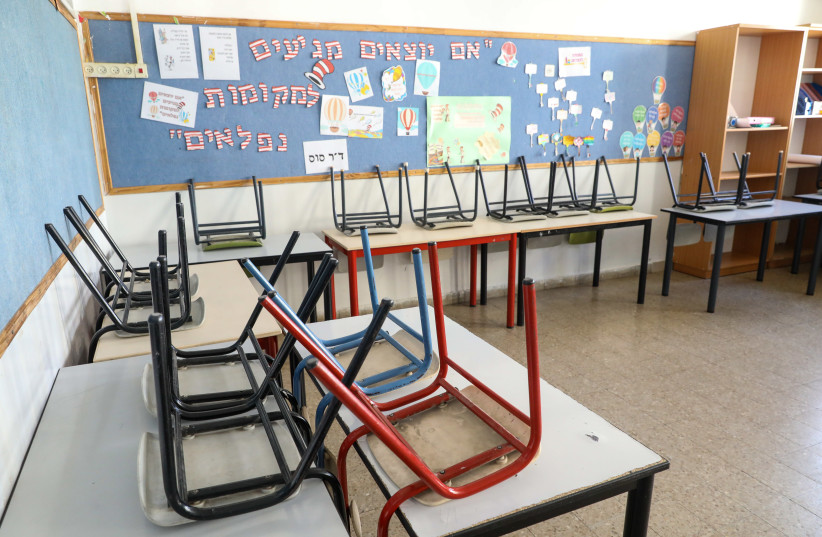Jerusalem is the country’s largest Education Ministry district, with over 200,000 students of all grades divided into several streams.
The Religious Zionist community makes up about 23% (or 130,000) of the city’s total Jewish residents, and their children have approximately 82 state-run religious elementary and high schools (including junior high) at their disposal (48 elementary schools, and 34 high schools).
There is consistent diversity among mamlachti dati (religious state education) schools. The schools are run according to various concepts and models. These range from institutions with strict gender segregation beginning in elementary school, to mixed schools for girls and boys from elementary through high school; and other schools where children study in coed classes until fourth or sixth grade, depending on the individual school’s policy.
There are liberal and pluralistic high schools such as Hartman, Pelech, Himmelfarb, and Ohr Torah Stone. Then there are those that are run like high school yeshivas (for boys) and seminaries (for girls) that place additional emphasis on the Torah aspect, such as Yeshiva Shefa, Yeshiva Noam, Kiryat Noar, Taliya, Zviya, and the Bnei Akiva network.
Furthermore, there are unique schools operating in the city such as the experimental school,Hamad Hillel, as well as the religious anthroposophical school Shovach. Tuition is determined according to Education Ministry guidelines, but it is usually very high.

The diversity of Jerusalem's Religious Zionist education
According to the figures provided by the city’s Education Administration, the 2022 student breakdown comprised 25,887 students in the Religious-Zionist stream (1,470 of whom were in special education, including advanced classes). Further elementary institutions had 14,635 students (with 610 of them in special education); and in secondary institutions, there were 11,252 students (with 894 of them in special education).
Parents and teachers say that in recent years there has been an improvement in the field of education and in the quality of the teaching; and we hear about schools (both elementary and secondary) that have made various changes to improve the level of the children’s education.
One example is the state-religious school Hamad Tirosh in Gilo, which received the 2021 national award in Religious-Zionist education, after undergoing significant changes and improvements, including in management and administration.
“This is an educational system that tries to ‘see’ the children,” says Anat Mofkadi, social activist and member of the board of a sate-religious education school in the Jewish Quarter, where two of her children study.
“I see an attempt to introduce innovation into the educational system in these institutions. The aim is to teach with innovative tools,in a way that today’s classrooms are very different from the classrooms we knew when we were at school.”
Mofkadi says she is not opposed to the use of these new and innovative tools but points out that what is special is that the values that the system conveys continue to be traditional.
“The religious education system is very complex because it consists of a system of religious studies and regular state-curriculum studies. It is a very challenging system to maintain this combination. It means, to my understanding, that the students get different messages that echo each other, and I think these are interesting processes.”
But Mofkadi says that there is more that makes up the particularity of this stream.
“In the state-religious stream, usually, a community system is created around the school, parents, students, teachers, creating a school that is a community and a community that is a school. This is something unique to state-religious education; these are systems that create a very significant voluntary system, in which everyone is active – students, parents and teaching staff – creating a space in which the youth, students, and its graduates are very active.
Yet, it is impossible not to mention the “elite” state-run religious schools. These have created a very specific population section that can be found in the best of these schools – and others who won’t be there.
One of the reasons is cost. Too often, in state-religious education, certainly in middle and upper schools, tuition is extremely expensive and thus only certain populations can access the best education. Tuition can run from NIS 6,500 to NIS 8,600 per month to cover the costs of additional hours in various topics that are included in the child’s schedule after consultations between parents, principals, and their teams, and the city’s Education Administration.
“This is true, sadly,” says Mofkadi, adding, “I believe in a system that includes everyone, with the aim of not creating stigmas, that says there is a place for everyone. And it’s a shame it’s not like that.”
First choice for students is the boys’ Himmelfarb High School in Bayit Vagan, with 174 first priority applicants; the girls’ Horev school comes in with 151 applicants. Third choice, by a large margin, is Yeshiva Mekor Haim-Shefa, with 105 applicants, followed by Noam, with 94 of sixth graders marking it as their first choice.
In fifth place is the boys’ Yeshiva Horev, with 92 applicants. This is followed by Hartman High School, with 84 applicants; Ort Banim, with 81; Midreshet Ohr Torah Stone, with 80; Ulpanat Emunah for the Arts (Alma Emunah), with 76; and Ulpanat Tzvia Creative, with 66 high school students who registered it as their first choice.
For about a decade, the most prestigious schools have the most applicants every year, but not everyone can get in. How did this happen? Twelve years ago, when Nir Barkat was mayor of Jerusalem, he opened up registrations in schools across the city to everyone, regardless of their place of residence. Students could choose their preferred schools instead of having to begin first grade or middle school at the educational institutions closest to their homes. Most students and parents were unhappy about it initially, claiming it would create students gaps between elitists and other schools. However, since then, student satisfaction rates range from 80% to 90%. ❖
